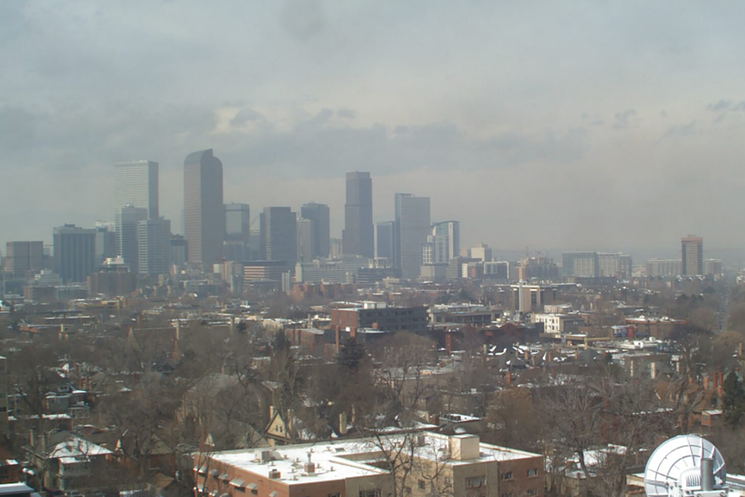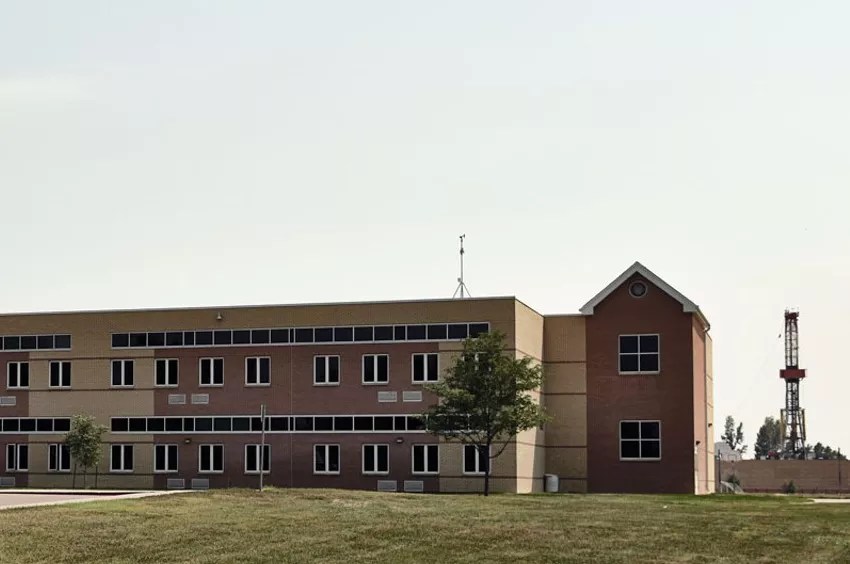
CDPHE

Audio By Carbonatix
The Colorado Air Quality Control Commission acted “contrary” to the state’s landmark Environmental Justice Act when it created a new rule for air permits in disproportionately impacted communities earlier this year, say some environmental groups.
Represented by the environmental firm Earthjustice, community organizations GreenLatinos, 350 Colorado and Earthworks filed a lawsuit in state court on Monday, August 21, challenging the new rule and asking that it be sent back for revisions.
The rule centers around extra protections in Title IV Clean Air Act permits for disproportionately impacted communities, where “the proportion of households that are low-income, that identify as minority, or that are housing cost-burdened is greater than 40 percent,” according to state officials. It includes “enhanced modeling and monitoring requirements for new or modified air pollution sources” and requires that all permit applicants “submit an environmental justice summary with their application” and install any control technology that is “technologically and financially feasible for the pollution source to install.”
The state’s new rule doesn’t require enough source-specific monitoring, charges the lawsuit, and it limits enhanced modeling to a small set of polluters and pollutants while dividing disproportionately impacted communities – which have historically borne the brunt of pollution – into two groups.
Residents are sick and tired of the pollution and want the state to do something about it.
“Enough is enough,” says Lucy Molina, a front-line community organizer for 350 Colorado who has long pushed to hold the Suncor oil refinery in Commerce City accountable. “It’s frustrating. … The system is working as designed, and it’s not designed for the people.”
The Environmental Justice Act, passed in 2021, aims to correct historical inequities and protect communities from pollution. It directed the AQCC to adopt enhanced modeling and monitoring requirements in disproportionately impacted communities, such as the neighborhoods around Suncor.
“These modeling and source-specific monitoring requirements are necessary to meet the goal of reducing pollution in those communities, in part because neither the state nor the DI Communities can successfully reduce pollution without reliable data on the source and quantity of those pollutants,” argues the Earthjustice lawsuit.
“When we look at the rulemaking that occurred, we don’t see that there was sufficient air monitoring,” says Patricia Garcia-Nelson, fossil fuel just transition advocate for GreenLatinos. “What we would have liked to have seen is some sort of strong protection for communities.”
Under the AQCC’s May ruling, very few sites would be required to do source-specific monitoring, which is necessary to combat pollution, according to the lawsuit. Instead, most entities applying for a permit would have to pay a community monitoring fee ranging from $50 to $750 per relevant pollutant to contribute to monitoring in the general area.
Ian Coghill, one of the Earthjustice attorneys in charge of the suit, says that the statute clearly intends for monitoring to be source-specific rather than just occurring in these communities.
“For me, it really is personal, because I have been working on getting air monitoring at Bella Romero [Academy] in Greeley, and so I know what it’s like to be a parent that’s concerned about your child’s safety,” Garcia-Nelson says.
She got involved with environmental justice while opposing a fracking project planned right next to the school – where her son was a student – five years ago. Since then, she’s worked to get air pollution monitors for the school. She calls the new fee system proposed by the AQCC “laughable.”
Garcia-Nelson says she partnered with 350 Colorado to get a $500,000 grant from the EPA to monitor the air near Bella Romero and another school in Greeley. That amount will allow for eighteen months of monitoring.
This is why she’s suspicious about whether fees – hovering around a maximum of $5,000 per permit – will actually provide enough funding to implement air monitoring at all.

An Extraction Oil and Gas drilling site less than 700 feet from the playground at Bella Romero Academy in Weld County.
Anthony Camera
“It’s a form of keeping people complacent,” Molina says. “Like, oh, look, we’re doing something but we’re really not. … These entities have been allowed by our own government to self-regulate. The baby became a teenager. He’s got an attitude now, and we’re trying to calm him down, and it’s out of control.”
As the suit alleges, the AQCC ruling doesn’t explain how the community monitoring program will work, its anticipated cost, the number of sources involved, or the rationale for the fee schedule.
“There’s no justification for why the fee table was appropriate or even what it’s going to accomplish,” Coghill points out.
Environmental groups also take issue with the fact that the AQCC ruling didn’t apply the stricter permit requirements to any hazardous air pollutants other than benzene, toluene, ethylbenzene and xylene, which are specifically named in the law. Although the Environmental Justice Act allows the commission to do so, it didn’t – despite the groups suggesting several that would be relevant.
The Earthjustice coalition also estimates that in any case, out of the nearly 5,000 air pollution permits the state issues per year, fewer than 100 would be subject to enhanced modeling or source-specific monitoring for those four pollutants. “It is simply just part of our job to say no and to push our agency leaders and our industry leaders to do the best that they can,” Garcia-Nelson says. “I simply don’t believe that they can’t do better.”
Lastly, the lawsuit argues that the AQCC shouldn’t have used its environmental mapping tool EnviroScreen to divide communities into “cumulatively impacted communities” and “socioeconomically vulnerable communities.”
Permit applicants would only have to do modeling or monitoring on site in cumulatively impacted communities. The rest would just pay the community monitoring fee to which the lawsuit also objects.
The problem is that EnviroScreen uses a criteria of 35 different factors to determine the level at which a community is impacted by pollution – and only five of them relate to air pollution.
According to the Earthjustice suit, only 139 of the 310 areas that meet the definition of a disproportionately impacted community and score high on EnviroScreen for air toxics emissions would be classified as cumulatively impacted communities under the AQCC rule.
“It’s actually cutting a large number of communities that could potentially benefit the most from more monitoring or modeling out,” Coghill notes. Beyond that, it just isn’t right to separate disproportionately impacted communities into classes, the plaintiffs argue.
“We definitely feel that when holding the industry accountable for monitoring to protect public health, it needs to be the same across the board,” Garcia-Nelson says. “Everybody deserves to be protected.”
In a joint statement sent to Westword, the Colorado Department of Public Health and Environment and the AQCC said they are both aware of the lawsuit and are reviewing it.
“The department and the commission remain committed to protecting air quality for all Coloradans, no matter where they live,” the statement says. “The rule amendments the commission adopted in May 2023 demonstrate this commitment by taking full advantage of the authority granted by the Colorado Environmental Justice Act and incorporating feedback from community members and other stakeholders that strengthened the rule.”
The CDPHE is committed to doing more to help impacted communities when it comes to air pollution, the statement adds: “The department has always prioritized the health and well-being of every Coloradan and knows there’s still more work to do.”
The goal of the Earthjustice coalition is to see all pollution sources required to conduct source-specific modeling, and a decrease in air pollution in communities as those sources are held accountable.
“The state needs to be a better example,” Molina concludes. “Other states are looking to the work we’ve done. We can do better.”